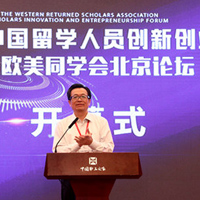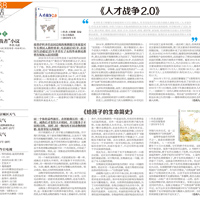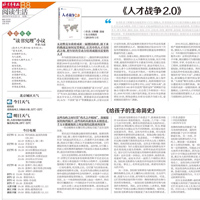- 当前位置:
- 首页>
- 活动>
- ������������
������������
CCG持续关注国际关系议题,推动中国与全球化的发展,积极开展国际交流,充分发挥智库“二轨外交”作用,在巴黎和平论坛、达沃斯世界经济论坛、慕尼黑安全会议等重要国际政策与意见交流平台上组织分论坛、边会、圆桌会议、晚宴等活动,促进国际政商学界对话,凝聚共识;CCG积极与各国政界、智库界、工商界开展“二轨外交”活动,每年常态化赴多国调研与交流,促进中外关系攸关方互动,保持与多国政策圈层的沟通渠道。
-

【经济导报】李卓彬:留学人员和新侨人才是改革开放深度推进的强大动力
中国侨联副主席李卓彬在论坛上致辞中国侨联副主席李卓彬近日在出席中国留学人员创新创业论坛时致辞并表示,广大留学人员和新侨胞不仅是中国过去四十年改革开放的独特记忆和重要资源,也是未来改革开放深度推进的强大动力和重要资源。 2018年8月19日,由欧美同学会(中国留学人员联谊会)主办,全球化智库(CCG)承办的第13届中国留学人员创新创业论坛暨欧美同学会北京论坛在北京举行。 李卓彬表示,中国改革开放四十年来,广大留学人员饱含爱国之情、报国之志回到祖国,积极投身中国现代化建设之中,为推动中国经济社会发展作出重要贡献,是中国改革开放和现代化建设事业的开拓者、参与者和贡献者。在“一带一路”建设等重大国家战略中,留学人员充分发挥人才引领作用,促进中国经济发展方式转变和结构升级,成为创新型国家建设的先行者和生力军。 李卓彬指出,留学人员与侨胞有着紧密的天然联系,其中新侨胞同海外侨胞一样,长期生活在海外,具有数量多、层次高的特点,已经成为侨界迅速崛起的新生力量。 “致天下之治者在人才。人才是实现民族振兴,赢得国际竞争主动的战略资源”。李卓彬强调,广大留学人员和新侨人才有良好的教育背景、开拓的国际视野和突出的创新能力,不仅是中国过去四十年改革开放的独特记忆和重要资源,也是未来改革开放深度推进的强大动力和重要资源。希望广大留学人员、新侨人才能够不忘初心,勇於担当,继续把爱国之情、报国之志融入祖国改革发展的伟大事业之中,融入人民创造历史的伟大奋斗之中。 李卓彬表示,随着世界多极化、经济全球化、文化多样化、社会信息化的深度发展,全球正处於深刻科技革命和产业变革进程中,希望广大留学人员和新侨人才能够勇於成为引领者,创新创业,建功立业,积极参与和促进新技术新产业新业态发展,为推动中国经济转型升级作出贡献。 “‘一带一路’倡议以共商共建共享为原则,是中国为世界提供的一项充满东方智慧的共同繁荣发展方案”,李卓彬表示,国之交在於民相亲,民相亲在於心相通。在全球经济治理结构调整时期,希望广大留学人员和新侨人才发挥优势和所长,在中国“一带一路”建设的民间友好交往中成为链接世界的纽带,为促进中国海外合作发展发挥积极作用。文章选自经济导报,2018年8月23日
2018年8月24日 -

[ 经济导报 ] 王辉耀:人才开放是未来改革开放深度推进时期的新特征
2018年8月3日,国务院发布《国务院关於取消一批行政许可等事项的决定》,包括取消11项行政许可等事项。其中对取消台港澳人员在内地就业许可事项,在取消审批後,人力资源社会保障部将在台港澳人员就业服务、社会保障、失业登记、劳动权益保护等方面,出台配套政策措施完善监管,进一步便利台港澳人员在内地就业发展。 全球化智库(CCG)理事长王辉耀在接受香港《经济导报》记者采访时表示,结合当前经济趋势和相关政策,取消台港澳人员内地就业行政许可事项,标志着中国或已从人口红利时期进入人才红利时期。港珠澳大桥通车在即,对这一行政许可的取消,将推进港澳人才在大陆汇聚和发展,有效利好粤港澳大湾区建设和大陆经济转型突围。全球化智库(CCG)理事长王辉耀 这并不是王辉耀首次面对媒体陈述上述观点。在2016年,全球化智库向中央政府递交《关於成立国家移民局》的建议,得到习近平、李克强、张高丽、王沪宁、栗战书等中央领导的批示。王辉耀在其署名文章中认为,“我国正在经历经济发展的转型时期,创新驱动发展,实质上是人口红利向人才红利的转变。建立移民局,也符合国家从招商引资向招财引智转型的要求”。这是他在两年前发表於《北京青年报》文章中对成立国家移民局必要性的阐述。人才政策助力粤港澳大湾区建设 8月3日,国务院发布《国务院关於取消一批行政许可等事项的决定》。同日,东莞市政府在政府常务会议上审定了《特色人才目录(2018年-2019年)》。东莞市市委副书记、市长肖亚非与会强调人才是立市之本。同日,上海市高校毕业生就业工作联席会议制定并公布《2018年非上海生源应届普通高校毕业生进沪就业申请本市户籍评分办法》。其中包括北京大学、清华大学应届本科毕业生符合基本申报条件可直接落户的绿色通道政策。自今年年初至今,中国多个一线、二线城市相继强化宣传各自的人才引进政策,人才竞争态势或已形成。 随着经济转型任务深化,科技创新引领经济发展渐成主流。作为《国家中长期人才发展规划纲要(2010年-2020年)》起草人之一的王辉耀,参与了该纲要中国际人才战略部分的起草和编写。他在采访中指出,随着科技群体渐成人才效应,跨越当前十年的国家人才发展规划基本完成既定任务,2020年後的国家人才发展规划中的人才需求趋向将强调向金融、服务业等领域的转向。 作为世界金融中心之一的香港,以其为重要支点的《粤港澳大湾区发展规划纲要》出台时间日益临近。王辉耀谈道,粤港澳大湾区发展的规划直接影响着该地区改革开放四十年後的新征程道路。其打造国际一流湾区和世界级城市群以参与全球竞争的宏大目标能否有效推进,人才建设是核心要素和成败关键。 “港珠澳大桥通车是大湾区建设的硬件基础,人才流动开放是软件基础,两者共同融合形成推进大湾区规划发展大战略的新支点”。 王辉耀指出,“更重要的是推动人才自由流动”,针对台港澳人员内地行政许可事项的取消恰逢其时。王辉耀在其发表於《北京青年报》的最新文章《为粤港澳大湾区建设架起人才流动之桥》中陈述,粤港澳三地可以在三个方面进一步加强协作,推动大湾区人才流动,“首先,在大湾区内探索建立人才保税区,对在区内创新创业人才予以个人所得税徵收优惠。其次,三地高校、科研机构可探索联合办学,或联合开展国家级大型科研项目研究,以项目聚集三地人才,涵养合作氛围。再次,推动三地国际人才自由流动。粤港澳大湾区可以作为中国加大国际人才引进的试点。” 此外,王辉耀在采访中表示,“港澳地区相关政府部门应尽快出台相应政策,放宽大陆人才进入港澳地区就业创业的行政许可门槛,必要时应适度考虑取消类似行政许可事项,进一步促进港澳地区和大陆地区人才通畅流动”。人才开放助推中国全球化发展 王辉耀认为,随着经济高质量发展需要,中国只有成为全球人才汇聚之地,才能形成持续影响力和可持续发展能力,港澳台地区在金融、服务业等产业及领域拥有先发优势,中国经济要转向通过释放人才红利获得高质量增长,应首先将港澳台地区作为前沿地域考量。 王辉耀指出,“中国国际人口占比的实际情况说明,中国充分利用国际人才尚有很大提升空间。中国改革开放前四十年是最初以深圳 为试验田开启的机构、货物、物流开放,随着港澳台人才在大陆就业的行政许可事项取消,标志着中国改革开放迈入新起点,即人才流动开放。在全球化时代,中国要形成人才资源储备,首先可以将大中华地区人才汇聚起来。从长远看,人才开放将辐射大中华地区经济建设,将这一区域华人联系在一起,契合大中华地区发展整体利益”。 在近日於北京举办的第13届中国留学人员创新创业论坛上,王辉耀再次表示,“新时代广大留学人员的使命必将为持续推进中国改革开放,为中国的全球化进程和中国下一个40年更高层次的开放做出更大的贡献”。他在演讲中通过回顾一百四十余年间中国留学浪潮,表示“海归从拯救中国到建设中国,到创新中国,从留学潮到海归潮,已经形成了中国独特的世界级的国际人才流动的良性循环的现象,这种大进大出与中国探索独立道路的历史有关,对中国的现代化和全球化的发展起到了重要作用。” 王辉耀认为,中国人才红利转向并不意味着人口红利的完成。他进一步指出,“我们对於人才的定义,不能仅以大学教育为参照标准,优秀成熟的手工业从业者也是人才”。 王辉耀在采访最後表示,“在过去改革开放四十年间,人才储备帮助世界走进中国,也帮助中国走向世界。在改革开放下一个四十年的新征程,全球人才资源要帮助世界了解中国,也要推动中国更好地了解世界”。文章选自经济导报,2018年8月23日
2018年8月24日 -

北青报图书连载CCG图书(九) | 《人才战争2.0》
《人才战争 2.0》 | 王辉耀、苗绿 著“本书作者王辉耀为全球化智库(CCG)创始人,作者苗绿为CCG联合创始人兼秘书长。《人才战争2.0》以未来为视角,介绍了目前人才流动的情况以及全球人才市场未来的趋势,并详细分析了美国、加拿大、澳大利亚、德国、法国、英国、日本、以色列、印度、俄罗斯、新加坡、韩国的吸引高端人才的举措和移民政策。作者根据他国的经验提出了很多切实可行的方案和建议,使我们在未来愈演愈烈的人才战争中占据有利地位。”接替萨科齐任法国总统的奥朗德宣布放宽对年长移民入籍的要求:凡是超过65岁、在法国生活超过25年并育有子女的外来移民都将有权加入法国国籍 2016年8月22日宣布竞选下届总统的法国前任总统萨科齐是个“奥巴马”类型的移民之子,其父亲是匈牙利人,与一个法国女人结婚,然后在巴黎生下了他。然而,萨科齐政府似乎“排斥”移民的亲人团聚,还有“种族歧视倾向”。例如,2007年,法国移民部门公布移民的职业清单,以“欧洲人优先”为原则,批准东欧移民职业种类150个,对于非欧洲移民——特别是亚、非移民,职业种类仅有6个!萨科齐的移民政策非常务实、功利,移民政策完全为人才战争服务,大门只向高端人才敞开。他出任欧盟轮值主席时,建议欧盟成员国建立“欧洲移民壁垒”,大门只对各国需要的高层次人才打开:“我们(法国政府)实在无法给那些视法国为金山的人提供住房和工作……接受移民只限于接受国家所需的外来技术人才。” 2014年,接替萨科齐任法国总统的奥朗德表示:“法国是一个传统的移民国家。统计数据显示,每4个法国人中就有一人的祖父辈来自国外。外来移民是这个国家财富的重要来源之一,如果将他们拒之门外,那么法国就不能继续称之为法国了。”他宣布放宽对年长移民入籍的要求:凡是超过65岁、在法国生活超过25年并育有子女的外来移民都将有权加入法国国籍;并重申竞选时的承诺,即保障所有外国人在地方上的选举权。仔细看,这是“政客式的语言”——法国对年长移民的入籍要求依然很严苛的!2016年9月,奥朗德在视察中部城市图尔的一个难民安置中心和加莱附近名为“丛林”的难民营后,强硬表示将不允许“丛林”和类似难民营在法国存在,将驱逐没有获得难民身份的非法移民。 从萨科齐到奥朗德,虽然二者竞选辩论时针锋相对,但其共同的执政理念是:法国对于广泛接受移民和难民并不够开放。 那么,法国到底欢迎什么样的人移民呢? 历史上,法国曾有过三次大规模移民:19世纪后半叶法国工业革命时期、一战后和二战后,前两次移民主要来自东欧和南欧,第三次主要来自非洲的前法国殖民地。三次移民都补充了法国国内劳动力的匮乏,但20世纪70年代中期后,随着经济结构调整,劳动密集型产业纷纷倒闭,法国遂停止了移民并鼓励移民返回原籍,但执行效果并不理想。截至2015年末,法国共接收移民778万人,约占总居住人口的12%,主要来源国分别是阿尔及利亚(143万人)、摩洛哥(93万人)、葡萄牙(71万人)、突尼斯(39万人)、意大利(37万人)、土耳其和西班牙(各约30万人),中国人约11万。 2015年1月7日,法国巴黎爆发了“《查理周刊》惨案”——两名北非裔移民青年枪杀了该刊的12名编创人员,因为该刊用漫画形式讽刺穆斯林先知。2016年7月14日晚间,尼斯卡车袭击案造成84人死亡,一边踩油门一边向人群射击的凶手是一位31岁的突尼斯裔尼斯本地居民。背后是“文明的冲突”,折射出由来已久的问题——穆斯林移民对法国社会的融入困难。文章选自《北京青年报》,2018年8月22日
2018年8月23日 -

【人民网】逾60%留学人员回国发展 48万留学生开启就业创业之路
人民网讯 四十年的改革开放历程中,一代代年轻人走出国门、走向世界,丰富知识、增长见闻。四十年来,在党和国家的关怀下,在“支持留学、鼓励回国、来去自由”方针政策的倡导下,中国留学事业发展迅速,为国家现代化建设培养了一批批高精尖人才。习近平总书记在“欧美同学会成立100周年”上说,“实践证明,广大留学人员不愧为党和人民的宝贵财富,不愧为实现中华民族伟大复兴的有生力量”。 教育部数据显示,改革开放以来,各类出国留学人员累计达519.49万人,其中60%以上的留学人员在完成学业后选择回国发展,2017年我国留学人员回国人数达到48.09万人,越来越多具备全球化视野和高新技术人才的海归留学人员活跃在中国经济快速增长的各个领域。 全球化智库(CCG)与智联招聘联合发布的《2018年中国海归就业创业调查报告》(后文统一简称“报告”)对以“90”后为主体的新生代海归群体就业创业状况进行了深入调查分析。报告显示,留学低龄化趋势明显,高中留学生人数增加,海归群体中本科学历出国留学的占比最高,达到51.54%,高中留学占比达29.79%,与2017年调查结果相比提高了9个百分点。在出国留学意义中,丰富阅历成为选择留学的最主要原因。英国、美国、澳大利亚、日本和韩国仍然是海归群体留学的主要选择国家,经济学与商学类也是最近一次留学中占比最高的主修科目。调查还显示,留学收获达到预期值 拥有海外工作经验的海归比例增加,金融业就业比例超过信息技术服务业升至第一位。 在就业创业方面,留学人员归国以后从事的行业广泛分布在金融、软件和信息技术服务、制造业等众多领域,其中金融业从业人员所占比例为14%、软件和信息技术服务业占13%、制造业占12%、教育占11%。另外,5%的留学归国人员选择创业,信息传输、软件和信息技术服务业、批发和零售业、教育等是主要创业领域。报告还显示,高达61%的海归群体选择回到自己家乡发展,但北京、上海、广东由于“经济发展快”、“国际化程度高”、“具有多元文化,包容性强”等优势,仍然成为海归人才的就业创业的首要目标城市,东北和中西部地区面临严重的人才流失问题。 难以割舍的家国情怀、国内广阔的就业创业空间以及自身多元文化经历的优势促使海外留学者回国发展。报告表明,近67%以上的海外留学人员是为了方便与家人、朋友团聚而选择回国,40%以上的留学生回国是因为国内经济发展的良好趋势。近年来,随着国内各大城市“人才大战”的炽热化,留学归国人员也成为各城市的重点招揽对象。与国内从业者相比,海外归国人员在语言交流、海外市场熟悉程度、跨文化沟通能力、创新和批判性思考能力等方面具有一定优势,为各地经济贸易以及文化创新事业的发展贡献了大批优质人才。 报告也指出,虽然95%的海外留学归国人员可在归国后半年内找到工作,但他们是在就业创业中同样也面临一些困境。与2017年,海归群体收入与预期矛盾进一步加剧,80%的海归认为收入水平低于或远低于个人预期,企业发展前景不明、职位晋升受限等问题,也使得海归们很难长期稳定于一个工作岗位。此外,创业运营成本高、相关创业服务不到位、技术成果转化难等问题也是海外留学者们在归国创业路上需要扫清的障碍,创业者对国内市场环境认识不清也是导致创业困难的重要原因。文章选自人民网,2018年8月22日
2018年8月23日 -

【CISION】Overseas Returnees to China Have Bright Prospects for Employment and Entrepreneurship
BEIJING, Aug. 21, 2018 /PRNewswire/ -- Zhaopin Limited ("Zhaopin" or the "Company"), a leading career platform in China focused on matching talent with skills and opportunities through their career lifecycle, and the Center for China and Globalization (CCG), a leading Chinese independent think tank based in Beijing, jointly released the "Report on Employment & Entrepreneurship of Chinese Returnees 2018".With the fast pace of economic growth in China, more and more overseas Chinese students are returning to China for career development or starting their own businesses. More than 480,900 overseas Chinese students returned to China in 2017, bringing the total number of returnees to over 3.13 million since 1978, according to statistics by the Ministry of Education.Zhaopin and CCG have been conducting their annual survey to track the employment trends of overseas returnees since 2015. This year’s report revealed the latest development in their employment and entrepreneurship endeavors, their choices and situations before and after studying abroad. The report is based on 2,190 effective survey responses from overseas returnees this year.Highlights for employment and entrepreneurship of Chinese returnees 2018:The top reasons for overseas Chinese to return to China: to reunite with family and friends (67%); China’s booming economic growth (40%); and unfavorable overseas economic, political and social environments, such as work and immigration policies (27%).About 61% of returnees went back to their hometowns in China. The rest relocated mainly to developed areas, including Beijing (13%), Shanghai (8%) and Guangdong Province (7%).The pace of local economic growth was an important reference for overseas returnees in their relocation decisions. While Beijing, Shanghai and Guangdong were attracting overseas returnees, the Northeast and Western China were losing overseas talent.About 65% of overseas returnees believed that the "Talent War" waged by cities to attract talent showed that local governments gave more importance and attention to talent, and 52% said more policy supports were needed for overseas returnees.Over 72% of overseas returnees were currently employed, 5% were starting their own businesses and 16% were still looking for jobs.About 42% of overseas returnees could find jobs within one month after they came back to China, and 41% could find employment in one to three months.In terms of salary, about 33% of overseas returnees had a pre-tax monthly salary below RMB6,000, 25% had a monthly salary of RMB6,001 to 8,000, and 15% earned RMB8,001 to 10,000 per month.About 80% of overseas returnees were not satisfied with their salaries. Among them, 49% said their salaries were below expectations, and 31% said their salaries were far below expectations.Studying overseasMore Chinese students chose to study overseas over the past decade. The top reasons were: to learn the culture and life of other countries and enrich personal experience (76%); to improve independent living ability (52%); and higher education quality abroad (51%).UK, US, Australia, Japan and South Korea were the top five destinations that attracted the most Chinese students.Destinations for overseas studyCountry/regionMaleFemaleOverallUK15.35%22.46%19.14%US21.23%15.18%18.01%Australia11.33%9.16%10.17%Japan10.19%9.91%10.04%South Korea8.90%8.78%8.84%Canada5.16%4.02%4.55%France3.30%5.52%4.48%Germany3.44%2.38%2.88%Russia3.01%2.38%2.68%New Zealand1.58%2.51%2.07%Hong Kong1.29%1.88%1.61%Netherlands0.57%0.75%0.67%Macao0.57%0.38%0.47%Sweden0.43%0.38%0.40%Taiwan0.29%0.38%0.33%Others13.34%13.93%13.65%Regarding majors chosen by Chinese students, 43% studied economics and business, 14% selected arts and humanities, and 10% engineering.Top ten majors selected by Chinese studentsMajorMaleFemaleOverallEconomics and business44.05%42.66%43.31%Arts and humanities7.46%19.70%13.99%Engineering15.21%4.64%9.57%Computer science9.76%1.38%5.29%Management3.01%6.78%5.02%Social Sciences and public health3.16%5.14%4.22%linguistics2.30%4.77%3.61%Environment / ecology2.58%1.13%1.81%Journalism and communication0.57%1.88%1.27%Chemistry1.72%0.88%1.27%As to the highest degree obtained overseas, about 56% of Chinese students got master’s degrees and 38% got bachelor’s degrees. An increasing number of students chose to study overseas for bachelor’s degrees.Degrees obtained overseasDegreeMaleFemaleOverallHigh school0.43%0.00%0.20%Associate1.58%1.88%1.74%Bachelor40.17%35.63%37.75%Master51.51%59.10%55.56%Doctor3.87%1.25%2.48%Others2.44%2.13%2.28%Returning to ChinaThe top reasons for overseas Chinese to return to China were: to reunite with family and friends (67%); China’s booming economic growth (40%); and unfavorable overseas economic, political and social environments, such as work and immigration policies (27%).Reasons for returning to ChinaReasonMaleFemaleOverallReunite with family and friends58%75%67%China’s booming economic growth47%35%40%Unfavorable overseas economic, political and social environments (such as work and immigration policies)24%29%27%Attached to Chinese culture and food19%27%23%Studied major has a good development prospect in China17%12%14%Has solid foundation for development in China12%14%13%Willing to contribute to the country17%8%12%Attractive policy for recruiting talent14%9%12%Good environment for entrepreneurship10%8%9%Others1%1%1%About 61% of returnees went back to their hometowns in China. The rest relocated mainly to developed areas, including Beijing (13%), Shanghai (8%) and Guangdong Province (7%). The pace of local economic growth was an important reference for overseas returnees in their relocation decisions. While Beijing, Shanghai and Guangdong were attracting overseas returnees, the Northeast and Western China were losing overseas talent.Relocation destinations for returneesLocationOverallHometown60.78%Beijing13.32%Shanghai8.43%Guangdong6.96%Zhejiang1.47%Jiangsu1.47%Sichuan1.27%Shaanxi1.00%In terms of overseas work experience, only 30% had no work experience. About 23% returned to China with 1 to 3 years of experience and more than 15% had over 3 years of experience.Overseas work experienceExperienceMaleFemaleOverallNo experience28.98%31.62%30.39%Less than half year14.35%14.30%14.32%Half to one year18.22%16.06%17.07%1 to 3 years23.10%22.96%23.03%3 to 6 years10.47%10.54%10.51%Over 6 years4.88%4.52%4.69%Most Chinese returnees had no overseas entrepreneurship experience. Only 4% had successful entrepreneurship experience.Overseas entrepreneurship experienceExperienceMaleFemaleOverallNo experience79.05%89.08%84.40%Failed experience14.92%8.53%11.51%Successful experience6.03%2.38%4.08%In recent years, a "Talent War" was waged in some cities to help attract talent with favorable policies. About 65% of overseas returnees believed that the "Talent War" showed that local governments gave more importance and attention on talent, and 52% said more policy supports were needed for overseas returnees.Opinions on Tatent War among citiesOpinionMaleFemaleOverallSuch policies to attract talent show the increasing importance and attention giving to talent64%66%65%More policy supports needed for overseas returnees52%51%52%Such policies have impact on city choice for employment and entrepreneurship34%36%35%Need longer time to see the effectiveness of such policies32%31%31%Others2%2%2%Regarding which incentive policies were needed to attract overseas returnees, top choices included: raising salaries and benefits (65%), improving employment mechanisms for returnees (57%), and providing household registration and housing (36%).Suggested policies to attract overseas returneesPolicyMaleFemaleOverallRaise salaries and benefits66%64%65%Improve employment mechanism53%60%57%Provide household registration and housing37%35%36%Provide entrepreneurship mentoring25%28%27%Establish platform for communications18%19%18%Provide career development advice12%15%14%Promote the government’s incentive policies10%13%12%Increase R&D investment11%10%11%Reward returnees who make great contributions11%10%11%Strengthen IPR protection9%7%8%Create sound environment governing by law6%8%7%Provide social inclusion support6%4%5%Improve system for technology conversion6%3%4%Others1%0%0%Employment for returneesAccording to the survey, about 72% of overseas returnees were currently employed, 5% were starting their own businesses and 16% were looking for jobs.Employment status of overseas returneesStatusMaleFemaleOverallEmployed71.77%72.60%72.16%Seeking jobs18.57%13.92%16.40%Starting own business3.51%6.17%4.75%Others6.15%7.31%6.69%When seeking employment in China, overseas returnees believes they had advantages in: language and cross-culture communications; global perspective; more adaptable and independent; and critical thinking capability.Advantages in seeking employmentAdvantageMaleFemaleOverallLanguage and cross-culture communications71%74%73%Global perspective60%58%59%More adaptable and independent33%40%37%Critical thinking capability25%25%25%Understand overseas market and can help build up brand and sales channels overseas15%17%16%More innovative17%14%16%Strong social interaction skills13%13%13%International cooperation12%11%12%Professional advantage11%11%11%Help to improve working ability5%8%6%Contribute to job promotion4%3%3%Easy to learn overseas technology3%3%3%Easy to hire overseas R&D talent and partner2%2%2%Easy to get overseas VC1%0%0%When looking for jobs, 49% of returnees applied through recruitment websites and APPs, 22% sent resumes directly to their target companies, and 19% relied on recommendations from their families and friends.Job-seeking channelsChannelMaleFemaleOverallRecruitment websites and APPs44.27%53.15%48.98%Applying directly to target companies26.68%17.66%21.89%Recommendations by families and friends17.59%20.28%19.02%Headhunters and HR intermediaries4.35%3.50%3.90%Offline job fairs2.57%1.05%1.76%Social media postings1.38%1.57%1.48%Overseas recruitment activities by government and companies1.19%1.57%1.39%Others1.19%0.87%1.02%Civil service examination and other government channels0.79%0.35%0.56%About 42% of overseas returnees could find jobs within one month after they came back to China, and 41% could find employment in one to three months.Time needed to find employmentTimeMaleFemaleOverallWithin 1 month42.69%40.91%41.74%1 to 3 months40.12%41.61%40.91%4 to 6 months12.45%12.76%12.62%7 to 12 months2.17%3.32%2.78%Over 1 years2.57%1.40%1.95%Top industries that hired overseas returnees included finance, communications, software and IT services, manufacturing, education, and wholesale and retail.Top ten industries for overseas returneesIndustryMaleFemaleOverallFinance16.80%11.71%14.10%Communications, software and IT services12.65%13.81%13.27%Manufacturing14.82%9.27%11.87%Education6.92%15.21%11.32%Wholesale and retail7.31%8.04%7.70%Culture, sports and entertainment4.15%10.31%7.42%Leasing and business services5.53%6.82%6.22%R&D and technology services5.53%3.85%4.64%Real estate5.34%3.67%4.45%Construction4.94%2.80%3.80%In terms of salary, about 33% of overseas returnees had a pre-tax monthly salary below RMB6,000, 25% had a monthly salary of RMB6,001 to 8,000, and 15% earned RMB8,001 to 10,000 per month.Salaries for overseas returneesPre-tax salary (RMB)MaleFemaleOverallBelow 6,00031.42%34.62%33.12%6,001 to 8,00023.12%26.05%24.68%8,001 to 10,00019.37%11.36%15.12%10,001 to 15,00014.43%14.86%14.66%15,001 to 20,0006.32%6.64%6.49%20,001 to 30,0003.56%3.50%3.53%30,001 to 50,0001.19%1.57%1.39%Above 50,0000.59%1.40%1.02%About 80% of overseas returnees were not satisfied with their salaries. Among them, 49% said their salaries were below expectations, and 31% said their salaries were far below expectations.Salary and expectation for overseas returneesComparisonMaleFemaleOverallSalary far below expectation31.42%31.29%31.35%Salary below expectation49.60%48.08%48.79%Salary matches expectation18.18%19.41%18.83%Salary above expectation0.59%1.05%0.83%Salary far above expectation0.20%0.17%0.19%Entrepreneurship for returneesAmong those returnees who started their own businesses, nearly half did so in 2017, compared with 18% in 2016 and 9% in 2015.Time to start own businessTimePercentageBefore 201525.35%20158.45%201618.31%201747.89%The top five industries that overseas returnees chose to start businesses were communications, software and IT services, wholesale and retail, education, manufacturing, and leasing and business services.Top five industries to start own businessIndustryPercentageCommunications, software and IT services16.90%Wholesale and retail15.49%Education11.27%Manufacturing8.45%Leasing and business services8.45%For their entrepreneurship endeavors, the supports they needed were: market development (41%); favorable environment for entrepreneurship (35%); financial services (34%); and entrepreneurship mentoring (25%).Supports needed for entrepreneurshipSupportMaleFemaleOverallMarket development33%54%41%Favorable environment for entrepreneurship37%32%35%Financial services37%29%34%Entrepreneurship mentoring21%32%25%HR services23%14%20%Patent protection19%11%15%R&D7%25%14%Legal support12%11%11%Management consulting services5%14%8%Tax incentives12%4%8%Technology transfer9%4%7%Other supporting policies5%0%3%The challenges these entrepreneurs were facing included: high operation cost (56%); unfamiliarity with domestic market (38%); and difficulty raising capital (37%).Challenges for entrepreneurshipChallengeMaleFemaleOverallHigh operation cost44%75%56%Unfamiliarity with domestic market35%43%38%Difficulty raising capital40%32%37%Related entrepreneurial services not in place28%25%27%Government related policies not complete21%21%21%Difficult for technology conversion14%11%13%Not supported by domestic R&D12%4%8%Difficult for international expansion7%4%6%Others2%0%1%Overseas.zhaopin.com is Zhaopin’s overseas talent recruitment business, helping bridge China’s companies with overseas talent through online recruitment, campus activities and job fairs. Overseas.zhaopin.com has accumulated deep understanding of local company overseas recruiting demand, and helps overseas returnees identify suitable career development path. It is also a member of The Network, the world’s largest online recruitment alliance, which covers 138 countries with 59 HR service providers and over 356 million resumes.From CISION,2018-8-22
2018年8月23日 -

Wang Huiyao: Chinese overseas talents backbone of China’s development
This article is an excerpt of Wang Huiyao’s keynote speech at a forum on Chinese overseas talents and entrepreneurial innovation in Beijing. This year marks the 40th anniversary of China’s reform and opening-up.At its beginning, Deng Xiaoping’s two major decisions were to restore the college entrance examination and send students overseas for education, which laid the most solid foundation in terms of talents and intellectual support for China’s reform and opening-up and its rise to become the world’s second-largest economy.Over the past 40 years, the passion for overseas education has become an important part of China’s globalization.Chinese students studying abroad have played an active role in science, education, culture, healthcare, innovation, entrepreneurship, emerging economic sectors, the Internet, big data, artificial intelligence, personnel training and the development of high-tech industries. They are becoming an important force in China’s transformation to become an innovative country.Forty years on since the beginning of reform and opening-up, people with overseas education backgrounds have played a critical role in China’s development.Chinese overseas talents coming back to China./ VCG Photo.Promote innovation and development of China’s science and technologyThe returnees have set up a number of new scientific research platforms different from the traditional domestic ones, which have contributed to the significant rise of China’s basic scientific research capacity and led to world-leading scientific breakthroughs.Reform and innovate educational mechanism to promote China’s standing in the international academicSince the reform and opening-up, a large number of returned overseas students have entered universities. Some of them have become academic leaders and backbones of Chinese universities and have effectively promoted China’s position in the international academic community.Actively push China to engage in globalizationIn the 40 years of reform and opening-up, China has gone from isolation to being open, which has impacted the trajectory of China’s globalization. Nowadays, found in more than 100 countries and regions in the world, nearly six million Chinese overseas students play an active role as non-governmental messengers of China. They have become a bridge connecting China with the world.Inspire and lead the tide of Chinese entrepreneurshipThe high-tech industry and the emerging economic sectors are the main playgrounds for overseas students who return to China to start businesses. By introducing cutting-edge technologies, modern corporate management strategies, venture capital, international capital and various new financing models, they have promoted the development of emerging economic sectors and new technologies, including the Internet, IT, telecommunications, biomedicine, media, culture and education, etc.A think tank for governing the country and promoting rational and democratic decision-makingIn the modern society, more demanding skills are needed for state governance and decision-making. As an active force in dealing with China’s social affairs, returnees have been participating in China’s reform and opening-up and democratic undertakings.The new force in public diplomacy gives China a greater say in the worldReturnees often have rich connections and networks and are familiar with the foreign culture. They can often achieve better results than Chinese official publicity in communicating some major issues.Bring in new financing models and modern corporate management strategiesAt present, many international venture capital companies in China are headed by returnees. As a financing model introduced to China by returnees, venture capital has made outstanding contributions to the development of China’s entrepreneurship. These investments have sparked domestic enthusiasm for starting businesses and led to the progress of domestic venture capital industry.Lead social innovation in China and promote localization of multinationalsReturnees from all over the world have contributed to innovative models and breakthroughs in environmental protection, charity, public welfare, non-profit organizations and various social organizations. They have accelerated the development of China’s tertiary industry, hence becoming the mainstay of China’s economic development.In the 40 years of reform and opening-up, returned overseas students have helped the two-way interactions between China and the world. In the new era, it is more important for them to help the world understand China and get China better engaged with the world. Nowadays, Chinese overseas students have an obligation to work with people from all over the world in building the community of shared future for mankind.About Author Dr. Wang Huiyao, founder and president of the Center for China and Globalization(CCG), an independent think tank based in Beijing.From CGTN,2018-8-20
2018年8月23日 -

北青报图书连载CCG图书(八) | 《人才战争2.0》
《人才战争 2.0》 | 王辉耀、苗绿 著“本书作者王辉耀为全球化智库(CCG)创始人,作者苗绿为CCG联合创始人兼秘书长。《人才战争2.0》以未来为视角,介绍了目前人才流动的情况以及全球人才市场未来的趋势,并详细分析了美国、加拿大、澳大利亚、德国、法国、英国、日本、以色列、印度、俄罗斯、新加坡、韩国的吸引高端人才的举措和移民政策。作者根据他国的经验提出了很多切实可行的方案和建议,使我们在未来愈演愈烈的人才战争中占据有利地位。”无论默克尔政府或新一届德国政府,接下来的挑战是如何安置难民,让其中的人才有用武之地,把年轻的劳动力培训成德国需要的人才 作为欧盟创始成员国之一,德国的移民政策深受欧盟相关政策和劳动力市场状况的影响,尤其是欧盟2009年出台的蓝卡计划。蓝卡出台的背景是欧盟的高素质劳动力中非欧盟人口占比例太低,仅0.9%;相比之下,澳大利亚为9.9%,加拿大为7.3%,美国为3.5%。2007年,时任欧盟委员会主席巴罗佐认为,欧盟成员国需要对非欧盟高技能人才的录用及长期居留做出统一规定。2009年蓝卡正式出台,允许非欧盟高技术移民申请在全欧洲境内的工作许可。 德国2012年才全面实施欧盟“蓝卡计划”,此后迅速成为欧盟蓝卡的最大发行国,2013年发放的“蓝卡”有90%来自德国,彰显出德国在全球范围内争夺高水平专业人才的攻势。欧盟委员会对此颇有微词,认为一个国家“蓝卡”签署数量太多,正显示出该计划的失败,因为没能够在欧洲平均分布这些高素质的非欧盟移民人才。德国联邦统计局2016年7月发布的数据显示,2015年德国移民数量及净增移民数量均为史上最高。 与美国、加拿大相比,德国对留学人才的运用相对欠佳。德国的公立大学教育实力很强,而且不收学费,接收的外国留学生主要来自中国、印度以及东欧地区,整体上因科研支持不足、就业市场压力大、高收入者个人所得税较高等原因,较难挽留优秀的外国留学生。不过这并不绝对,一些博士毕业的精英还是被德国成功挽留,如上述张建伟博士。还有一些优秀留学生被德国机构或企业聘用,如上海市知联会外企分会副会长刘斌博士,他获得德国乌尔姆大学胰腺外科专业博士学位,决定“弃医从商”,进入德国具有160余年历史的“隐形冠军”老牌医疗设备公司爱尔博(ERBE),在总部工作和培训一年以后,2000年回到上海开设代表处,至2015年业务量增长33倍,销售业绩从全球32位跃升为前3名,受到德国总部的专门表彰。 2015年以后,德国专业人才会出现青黄不接,并将严重影响德国经济的持续增长——德国出生率低,德国人口正快速萎缩,而德国机器需要更多工人!当年德国宣布接收80万难民,是2014年接收人数的4倍!这背后的考量之一是德国技术人才供求不平衡,难民潮恰可为德国提供许多高素质人才,如工程师、学者、专业技术人员等;而且德国不仅需要工程师,还需要普通劳动力,如医疗护理人员,人手更短缺,非常适合难民。然而,随着成千上万的难民从战乱的中东地区涌入德国,恐怖分子也混杂其中,德国有些“消化不良”,涉难民的非法和暴力事件频发,新闻曝出在德中国女留学生也遭受难民的侵害。“大救星”默尔克陷入悲悯与两难的境地,总理之位遭受来自全德的挑战。面对既成事实,无论默克尔政府或新一届德国政府,接下来的挑战是如何安置难民,让其中的人才有用武之地,把年轻的劳动力培训成德国需要的人才,以及克服难民潮带给德国乃至欧洲社会的冲击。文章选自《北京青年报》,2018年8月21日
2018年8月22日